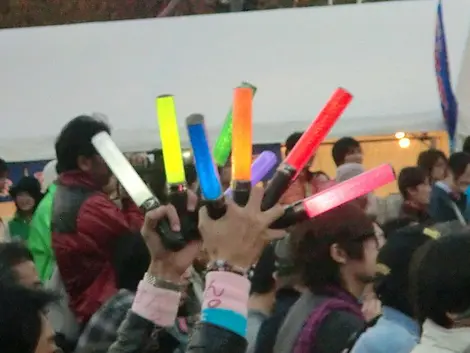Wotagei: the dance of idol fans in Japan
Wotagei, also known as otagei, is a unique Japanese art form that combines dancing, singing and colorful accessories. Born of the passion of male fans for their favorite idol singers, this form of expression has developed over the decades to become a veritable cultural phenomenon. Let's take a closer look at this spectacular art form, which draws crowds not only at concerts, but throughout the archipelago and beyond.
History and meaning of the term "wota"
The origins of wotagei date back to the 70s, when groups of fans gathered to support their idols by singing and choreographing songs during their performances. The term "wotagei" is actually a contraction of "ota" (オタ), short for otaku, meaning a devoted or even obsessive fan, and "gei" (芸), meaning "art".
In the 2000s, idol fans began calling themselves "wota" (ヲタ) to distinguish themselves from otaku, manga and anime fans. The term then spread to refer to all idol fans, including abroad. There are even variants such as Haro-wota for Hello! Project fans, or AKB-wota for AKB48 fans.
Features and accessories of wotagei dances
At concerts, wotas distinguish themselves by their outfits: brightly colored clothes, embellished with headbands and coats customized with the names and colors of their idols. But it's the glowing accessories like cyalumes, the famous fluorescent sticks known as "glowsticks", that make wotagei so special.
When waved rhythmically, they are used to perform elaborate choreographies synchronized to the idols' songs. Over the years, hundreds of different moves have been invented by wotas, some of which have become classics performed in concert after concert, such as the "Romansu", the "Over-action dolphin" or the "Senjyu cannon".
Examples of famous choreography and figures
Among the best-known sequences is the "Worawota Worawota", which consists of frantically waving the cyalumes up and down. Another classic, the "MIX", involves rapidly crossing and uncrossing the outstretched arms. Some figures pay tribute to specific songs, such as "Kecha", named after a track by the group Kecha.
Other moves play on striking large-scale visual effects, like the "Matrix", where hundreds of sticks light up in succession to create an impression of a luminous wave in the audience. Wotagei compete with each other to create ever more spectacular choreographies, even incorporating additional accessories such as fans and flags.
Specificities of wotagei according to the idol groups supported
While the basics of wotagei remain the same, each idol group has its own specificities reflecting theidentity of its fans. For example, Mo-wota fans of Morning Musume can be recognized by their bright pink outfits, the group's signature color. Perfume fans, on the other hand, wear color-changing cyalumes, reminiscent of the trio's electro-pop universe.
Even among fans of the same band, differences in style can appear. Within AKB-wota, for example, purists prefer sober, elegant movements, while others opt for a more extrovert, acrobatic wotagei. But all are united by their unwavering fervour for their beloved idols.
Internationalization of the wotagei phenomenon outside Japan
Like the otaku movement, wotagei has gradually conquered other Asian countries and even the West. More and more fans of J-pop and Japanese culture are getting in on the act, learning the choreography from Internet tutorials and performing it at conventions and concerts abroad.
This internationalization has encouraged the emergence of wotagei groups outside Japan, who make a point of remaining faithful to the original spirit of the practice. Some go so far as to travel regularly to Japan to perfect their technique with local wotas and experience special moments with their favorite idols, just as Japanese fans do.
Wotagei, an original way to express your passion for idols
Far from the clichés that reduce them to a horde of hysterical fans, wotas demonstrate through their art all the creativity and positive energy of those who devote themselves body and soul to their beloved artists. The Akihabara district, a mecca of Tokyo pop culture, regularly echoes to the sound of "Worawota Worawota" and other cheers provided by these peerless dancers.
More than just a hobby, wotagei has become a way of life for many, punctuated by the release of new songs, events, training sessions and the making of bespoke costumes. It's an all-consuming passion that even artists from other horizons, such asPerfume, enjoy putting on a video. Proof that the phenomenon has long since transcended the borders of J-pop to become an integral part of fascinating Japanese culture!

















